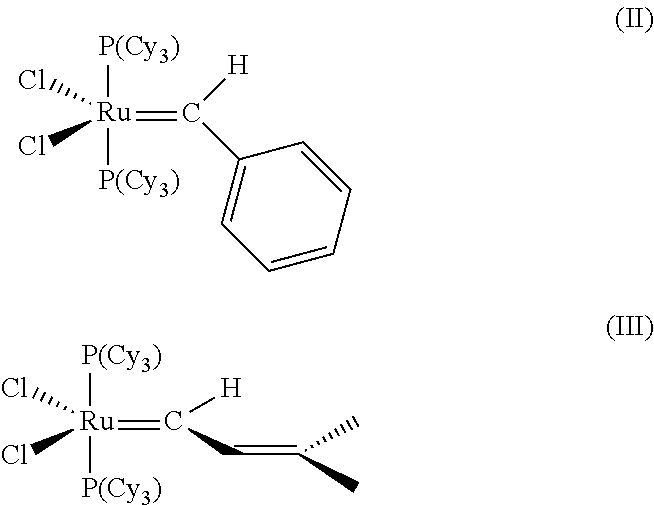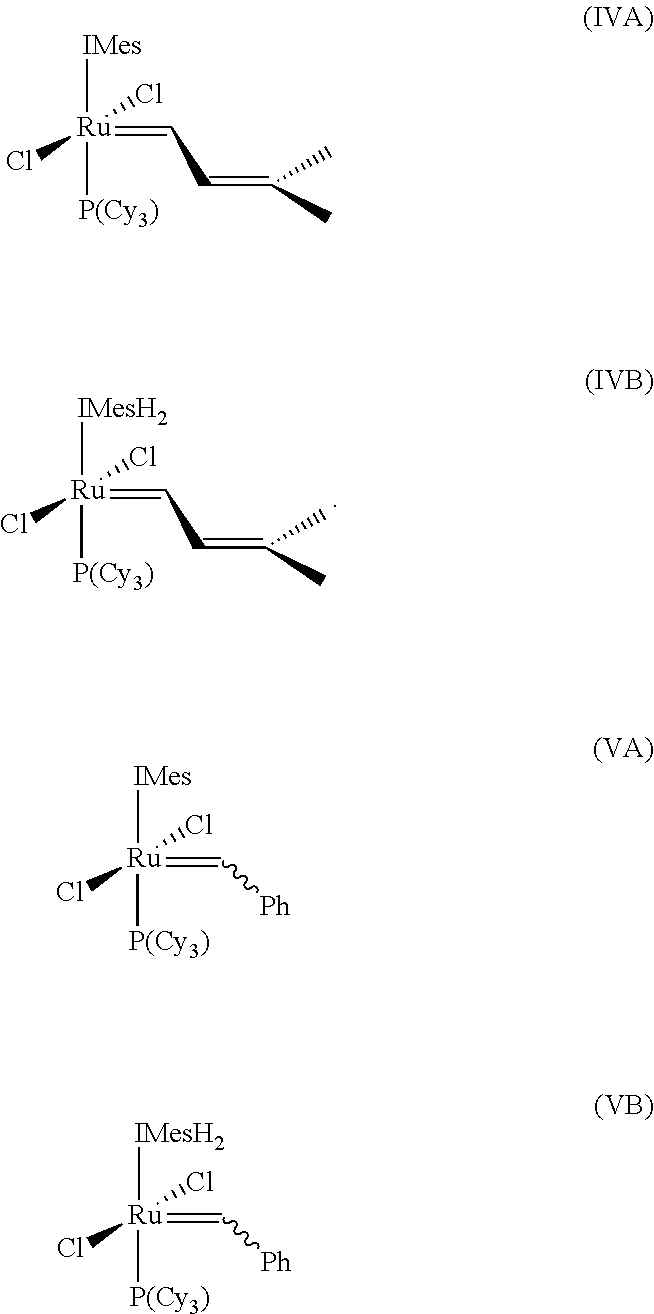Cross-metathesis reaction of functionalized and substituted olefins using group 8 transition metal carbene complexes as metathesis catalysts
a transition metal complex and catalyst technology, applied in the direction of group 3/13 element organic compounds, group 5/15 element organic compounds, hydrocarbon preparation catalysts, etc., can solve the problems of difficult substrates, low thermal stability of compounds, and few methods available for mild and selective synthesis of directly halogenated olefins
- Summary
- Abstract
- Description
- Claims
- Application Information
AI Technical Summary
Benefits of technology
Problems solved by technology
Method used
Image
Examples
example 1
Representative Procedure for Synthesis of Ruthenium Alkylidene Catalysts
Synthesis of RuCl2(═CH—CH═C(CH3)2)(IMesH2)(PCy3) (complex (2), Scheme 1)
[0137]
[0138][Ru(COD)Cl2]n (300 mg, 1 mmol), IMesH2Cl (1.47 g, 4 mmol), tricyclohexylphosphine (300 mg, 1 mmol), and KN(SiMe3)2 (540 mg, 2.5 mmol) were weighed directly into a 600 mL Schlenk tube. The flask was evacuated and filled with dry argon (2×). Degassed benzene (300 mL) was added and the flask was pressurized to 30 psi with H2. The suspension was vigorously stirred for 12 hours at 90° C., yielding a bright yellow solution and white precipitate (1). After cooling the reaction to 5° C., propargyl chloride (0.3 mL, 4 mmol) was slowly added via syringe and the reaction mixture was allowed to warm to room temperature. The resulting brown benzene solution was washed with degassed 1M HCl (2×), degassed brine (2×), filtered through Celite and concentrated in vacuo to afford compound (2) as a brown solid in 90% yield (˜95% purity). The brown s...
example 2
Synthesis of RuCl2(═CH—CH═C(CH3)2)(IMesH2)(PPh3) (complex (4), Scheme 2)
[0140]
[0141]The procedure of Example 2 was employed using [Ru(COD)Cl2]n(300 mg, 1 mmol), IMesH2Cl (0.74 g, 2 mmol), triphenylphosphine (280 mg, 1 mmol), and KN(SiMe3)2 (380 mg, 1.9 mmol), giving 550 mg (68%) of complex (3). 31P NMR (CD2Cl2): δ 24.0. 1H NMR (CD2Cl2): δ 18.49 (d, J=11.1 Hz, 1H).
example 3
Synthesis of RuCl2(═CH—CH-Ph)(IMesH2)(PCy3) (complex (5), Scheme 3)
[0142]
[0143]RuCl2(═CHPh)(PCy3)s (phenylmethylene-bis(tricyclohexylphosphine) ruthenium dichloride, “catalyst (I)”) (6.00 g, 7.29 mmol, 1.0 eq.), IMesH2.HCl salt prepared above (2 eq.), and potassium t-butoxide (2 eq.) were placed in a Schlenk flask. 60 mL of anhydrous degassed hexanes (Aldrich SureSeal bottle) were added. A vacuum was applied to further degas the reaction mixture, which was then heated to 60° C. for 24 hours. The suspension changed color from purple to orange-brown over the reaction time. After approximately 24 hr, the mixture was cooled to room temperature, and an excess of 1:1 isopropanol:water (180 mL) was added. The mixture was stirred rapidly in air for 30 min., then filtered using a medium porosity frit, and washed with isopropanol-water (3×100 mL) and hexanes (3×100 mL). The solids were dried in in vacuo, and the yield was approximately 75%. 1H NMR (CD2Cl2, 400 MHz) δ 19.16 (s, 1H), 7.37-7.05 ...
PUM
| Property | Measurement | Unit |
|---|---|---|
| temperature | aaaaa | aaaaa |
| thickness | aaaaa | aaaaa |
| temperature | aaaaa | aaaaa |
Abstract
Description
Claims
Application Information
 Login to View More
Login to View More - R&D
- Intellectual Property
- Life Sciences
- Materials
- Tech Scout
- Unparalleled Data Quality
- Higher Quality Content
- 60% Fewer Hallucinations
Browse by: Latest US Patents, China's latest patents, Technical Efficacy Thesaurus, Application Domain, Technology Topic, Popular Technical Reports.
© 2025 PatSnap. All rights reserved.Legal|Privacy policy|Modern Slavery Act Transparency Statement|Sitemap|About US| Contact US: help@patsnap.com



